How to find missing items for Casio CT-X700?
- TthomasdavidSep 23, 2025
Carefully check inside all of the packing materials.
How to find missing items for Casio CT-X700?
Carefully check inside all of the packing materials.
What to do if my Casio Electronic Keyboard display lights up but won't turn on?
If the display lights up briefly but the power doesn't stay on when you press the power button, press the power button firmly and completely.
What to do if no sound comes out when I press keys on my Casio CT-X700?
If pressing keys on your Casio Electronic Keyboard produces no sound, try the following: * Adjust the volume setting. * Check if anything is plugged into the back of the keyboard. * Turn the power off, then back on, to reset all keyboard settings.
Why does my Casio CT-X700 Electronic Keyboard make a loud sound and then turn off?
If your Casio Electronic Keyboard emits a loud sound before powering down, try replacing the batteries with new ones or switching to AC adapter power.
How to stop stuck notes on my Casio CT-X700 Electronic Keyboard?
If notes on your Casio Electronic Keyboard keep playing without stopping, try these solutions: * Turn the power off and then back on to reset the keyboard. * Replace the batteries with new ones or switch to AC adapter power.
Why do notes cut off while playing on my Casio CT-X700 Electronic Keyboard?
Notes are cut off when the number of notes being played exceeds the maximum polyphony, which is 48 (or 24 for some tones). This is normal operation.
Why does skip forward/back move multiple measures on my Casio Electronic Keyboard?
When song playback is stopped or a Step Up Lesson is in progress, skip forward and skip back operations are performed in phrase units.
Why are keys stuck on the screen of my Casio Electronic Keyboard?
If keyboard keys or notes remain on the display, a Step Up Lesson may be in progress, and the keyboard is waiting for you to play the next note. To stop this, cancel the lesson.
Why is auto accompaniment not working on my Casio CT-X700?
If nothing happens when you start Auto Accompaniment on your Casio Electronic Keyboard: * With rhythms 186 to 195, nothing will sound until you play a chord on the keyboard. Try playing a chord. * Check and adjust the accompaniment volume setting. * If there is no user rhythm stored in memory, Auto Accompaniment will not start when you press 8 while a rhythm in the range of 196 to 205 is selected. * Turn the power off and on again to reset the keyboard.
Why doesn't the volume change with my touch on my Casio Electronic Keyboard?
If the output volume on your Casio Electronic Keyboard doesn't change with your touch, adjust the Touch Response setting. You can also try turning the power off and on again to reset the keyboard.
| Product type | Digital synthesizer |
|---|---|
| Product color | Black |
| Sound effects | Chorus, Delay, Equalization, Flanger/Digital Signal Processing (DSP) |
| Volume control | Digital |
| RMS rated power | 5 W |
| Number of speakers | 2 |
| Chorus effects quantity | 20 |
| Keyboard number of keys | 61 |
| Maximum polyphony (notes) | 48 |
| Display type | LCD |
| Battery type | AA |
| DC input voltage | 9.5 V |
| Power source type | Battery, DC |
| Number of batteries supported | 6 |
| Depth | 350 mm |
|---|---|
| Width | 948 mm |
| Height | 109 mm |
| Weight | 4300 g |
Explanation of the keyboard's display indicators and screen elements.
How to use number and +/- keys for inputting values and navigating settings.
How to browse and select categories for tones, rhythms, songs, and presets.
Procedure to restore the keyboard to its original factory settings.
Guidance on setting up the included music stand for use with the keyboard.
Information on powering the keyboard using AC adaptor or batteries, including installation and safety.
Steps for powering on, playing notes, adjusting volume, using headphones, and managing power options.
Adjusting touch sensitivity, display contrast, using the metronome, and setting tempo.
Steps to choose from a wide variety of instrument sounds available on the keyboard.
How to combine multiple tones (Layer) or assign different tones to keyboard sections (Split).
How to apply and select different reverb and chorus effects to enhance the sound.
Adjusting sound quality with equalizer presets and applying effects with a pedal unit.
Adjusting the keyboard's pitch using transpose, fine-tuning, and octave shift functions.
How to play demonstration songs and select specific songs from the Song Bank.
Managing song playback and setting up specific measures for practice.
Adjusting song playback speed, volume, and matching keyboard tone to the song.
How to choose a song and specific parts (right hand, left hand, both) for practice.
Various practice methods including Easy Mode, step-by-step lessons, and playing without guidance.
How to divide songs into shorter phrases for focused practice.
Options to customize lesson features like voice fingering and note guidance.
Managing performance evaluation, phrase length, accompaniment simplification, and part channels.
How to activate and use Auto Accompaniment with rhythms, bass, and harmony parts.
How to input chords and select various chord input modes.
Explanations and examples of different chord types and assist modes for accompaniment.
Managing variations, intros, fill-ins, and endings for dynamic accompaniment.
Features for starting accompaniment automatically and setting optimal performance parameters.
How to select music presets and adjust the chord progression key.
Steps to select and configure Auto Harmonize types for enriching melodies.
Steps to select and apply different arpeggio patterns to create automatic musical figures.
How to use the Chord Book to identify chords and trigger Auto Accompaniment.
Step-by-step guide to saving current keyboard settings into registration memory.
How to load saved setups and prevent specific settings from being overwritten.
How to record keyboard performances, overdub tracks, and manage recordings.
Procedures for multi-track recording, muting tracks, and managing recordings.
Managing recording tracks, songs, and recording along with lessons.
How to delete recorded songs/tracks and save data to an external device.
Steps for navigating the function menu and selecting desired settings.
Adjusting pitch (transpose, octave), touch response, and tempo settings via the FUNCTION button.
Configuring reverb, chorus, equalizer, scales, and pedal effects through the FUNCTION menu.
Managing lesson features, performance evaluation, and phrase length via the FUNCTION button.
Adjusting MIDI settings, auto power off, and other system configurations using the FUNCTION button.
Steps to select from 17 preset scales and adjust the root note.
How to apply the selected scale to Auto Accompaniment patterns.
How to configure the appearance of the on-screen keyboard display.
Procedures for deleting all data or resetting specific function settings to factory defaults.
Steps and requirements for connecting the keyboard to a computer via USB for data exchange.
How to transfer data to/from a computer and download the Data Manager application.
How to connect the keyboard to audio equipment and external players.
How to use the Vocal Cut feature to mute vocals from audio input.
A guide to diagnosing and resolving common problems encountered with the keyboard.
Explains the meaning of error messages displayed on the keyboard and how to resolve them.
Technical details and specifications of the CT-X700 keyboard.
Important safety and usage guidelines, including location, maintenance, and etiquette.
A comprehensive list of all built-in songs categorized by type.
Visual guides for fingering chords and examples of chord voicings.
A chart detailing MIDI functions, messages, and their implementation for external control.
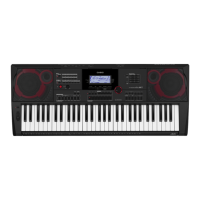
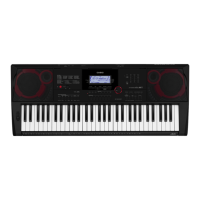
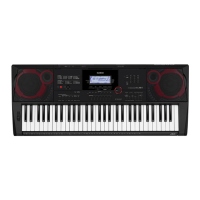

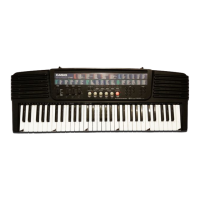
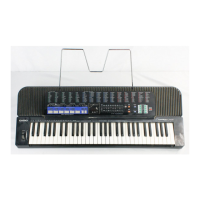
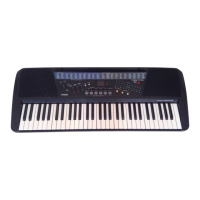
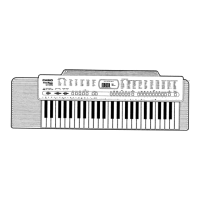
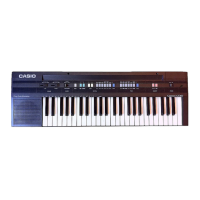
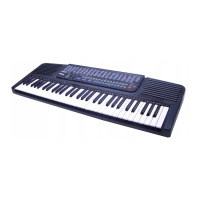

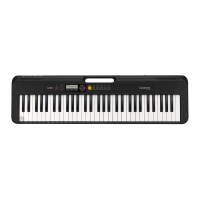
